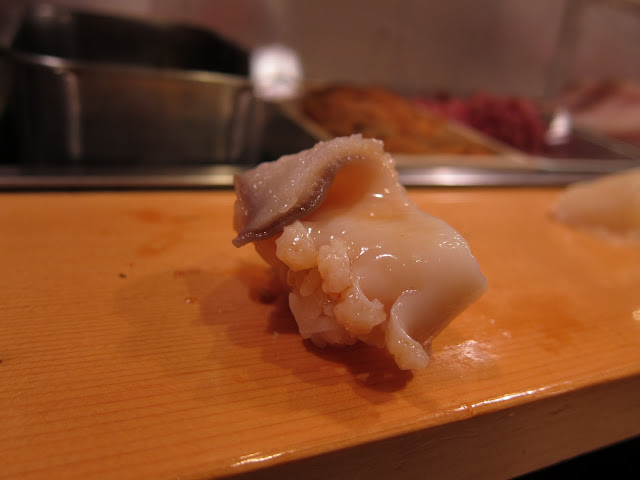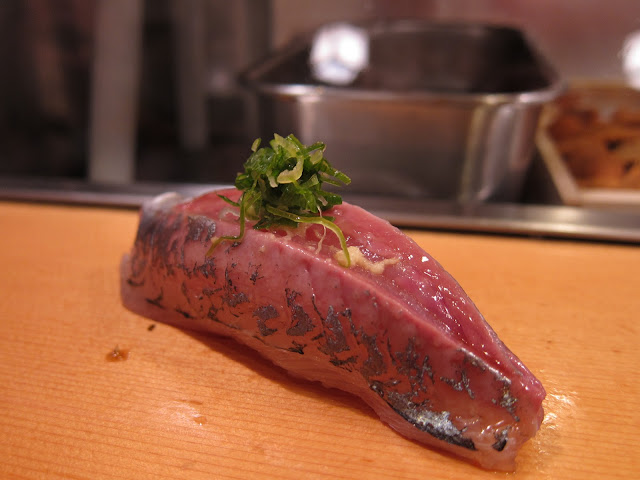It's 7am and after a ridiculously early start to the day to see the tuna auctions at Tsukiji Market (see my post here) my tummy is rumbling and its starting to feel like lunchtime already. Tsukiji Market is littered with lots of tiny restaurants along its narrow alleys with most, naturally, specialising in sushi. Having done a bit of research I decided upon Sushi Dai, which is generally perceived to be one of the best sushi restaurants in the market. Finding it was a bit tricky as there are no signs in English, but I was told to look for the restaurant with a green banner above the door and a long queue outside. Sure enough, as I rounded the corner, it was the only restaurant in the alley with a queue outside. After peering through the window I could see why; the place is tiny and has just 12 seats. Fortunately the wait was not too bad, just 30 minutes or so. Apparently queues of up to 3hrs are not uncommon later on in the day. There is a friendly lady who keeps popping out to organise the long queue and take pre-orders for the omakase (chef's) menu. Although too polite to say so, the staff expect you to eat and go without lingering, so the turnover of customers is pretty high.
So, is the queuing worth it? Well, in a word, YES! Sushi Dai serves some of the best sushi I have ever had in my life. This is the holy grail, the mothership, the promised land of all that is sushi. I am forever spoiled, I will never be able to look at another piece of nigiri again, without comparing it to Sushi Dai. Yes, it was that good. This could become an expensive addiction...
Upon entering the restaurant we were greeted by the usual greetings shouted out by the three chefs who were standing behind the counter of an impossibly narrow restaurant. Racks are made available to place bags and coats as there really isn't anywhere else to put them. We were ushered to two empty stools at one end of an L-shaped bar surrounding the chefs. I had opted for the 10 course omakase menu which also includes an additional piece of sushi of your choice. Although as I later found out the ten-course set menu was probably just a rough guideline as we received a few more dishes than that.
The three itamae's spoke a little English and would place great big pieces of nigiri sushi on the wooden counter in front of you (no plates here) with a flourish. Proudly announcing what it was and how it should be eaten; sauce/no-sauce, one/two bites. The atmosphere inside was fantastic, the chefs worked quickly and precisely, churning out stunningly fresh sushi at an incredible rate clearly happy with their work. When one squeamish customer returned a half eaten piece of uni nigiri (a capital crime in my book), their sense of disappointment was palpable. Like most of the other restaurants in Tokyo I went to, what impressed me most about Sushi Dai was the precision of the cooking, the attention to detail and the sheer freshness of ingredients.
To start the proceedings we were served o-toro (fatty tuna) which in my opinion is the emperor of sushi. This o-toro was unlike any other I have had. The first thing I noticed was how big the portions were, the fish seems to totally envelop the nugget of rice and spills down over its sides. The tuna had a beautiful spiders-web of rich marbling. Eating it was such a sensual experience; the cool flesh of the tuna juxtaposed by the perfectly al dente and lukewarm rice. I hardly needed to chew, the buttery tuna just melted on my tongue. Wow, I was speechless.
O-toro (fatty tuna belly)
Next was a trio of sushi. The uni (sea urchin) was so fresh and creamy with a wonderful ozone taste of the ocean. Tasting it I was transported to the south coast of Norway on a warm summer's day, breathing in the wonderful sea air. Truly outstanding, and a close tie with the o-toro for my favourite of the meal. Tai (red snapper) was next; a vibrant pink fish which had a pleasing firm texture. This was followed by suzuki (sea bass) which we were instructed not to dip in soy sauce as the chef had put a drop of sudachi (a kind of Japanese lime) and some homemade salt on it. This gave the fish an amazingly clear and zingy taste and was a wonderful complement to the moderately oily sea bass flesh. The chefs seem to judge the amount of wasabi they use to perfection with each piece having just the right amount.
L-R: Uni (sea urchin), Tai (red snapper), Suzuki (sea bass) with homemade salt and sudachi
Next it was back to earth for something a little more mundane. The tamago (egg) was served hot and with no rice. It was good with a slightly sweet finish, but let's be honest, it's the seafood I'm really here for.
Warm tamago (steamed egg)
Sake (Japanese salmon) was next, again no sauce with this one. What was unusual about it was the deep pink hue the fish had to it and the lack of fat, which was in contrast to the pale pink and flabby salmon that is so often seen in Europe. Like most of the ingredients used, the quality really makes you evaluate why this sort of thing isn't available outside of Japan. Certainly it should be possible back home in Norway which has some stunning seafood of its own. But I digress.
Sake (Japanese salmon)
Maki rolls were next. These were made with more of that wonderful uni and diced chu-toro (medium fatty tuna). From the photos you can really see how well the rice is cooked, with each grain having the same firm consistency. I'm running out of superlatives already, but as I'm sure you can guess, both were amazing. Before I came to Tokyo, I sort of knew that the quality of the seafood in the sushi would be outstanding but what surprised me most was the quality of the rice. Perfectly seasoned, served slightly warm with each grain being separate and cooked to perfection.
Maki rolls: Uni (sea urchin) and diced chu-toro (medium fatty tuna)
Maguro-zuke was next. This is tuna marinated in a mix of soy sauce, sake, and mirin. Again, no dipping in soy sauce for this one.
Maguro-zuke (marinated tuna)
And next, judging from other reviews I've read, was the party piece of Sushi Dai: Akagai (red clam). As the chef placed it in front of me it was still moving! It really doesn't come fresher than that. I was expecting this to be somewhat chewy but was surprised to find it almost as tender as the o-toro and had a mild taste of the sea.
Akagai (red clam)
Then we had kajiki (swordfish) which was topped by some finely shredded spring onions.
Kajiki (Swordfish)
Next was shira-ebi which consisted of a clump of tiny white prawns ("no sauce"). This was another real show-stopper, the translucent prawns were stunningly fresh with a wonderful sweet taste to them.
Shira-ebi (tiny white shrimp)
I'm not usually a fan of raw aji (horse mackerel) as I find it can be a bit overpowering and doesn't really sit well with the subtleties of a typical sushi meal. However, the aji here was wonderful. No overpowering fishiness at all, just a strong meaty taste, offset with a tiny bit of seaweed and ginger on the top.
Aji (horse mackerel)
Just for fun, they presented us with some kohada (gizzard shad. No, I didn't know either) that had been beautifully plaited.
Kohada (Plaited gizzard shad)
Next was hamachi (yellowtail) topped by batons of spring onion and wasabi. It was, of course, delicious. As part of the omakase meal, you could select one final piece of sushi. This proved much harder than it seems as I was torn between the o-toro, uni, shira-ebi, or something entirely different. In the end, I opted to get the most bang for the buck and went for another piece of silky soft o-toro. This was washed down with a rich miso soup which contained pieces of fish, and we re-entered earth orbit with plenty of matcha tea.
Hamachi (yellowtail)
The total bill came to JPY 3,900 which seemed like a bargain in relation to the quality of the food. Looking back now I can see that this was one of those life-changing culinary moments. When you experience food so amazing that it forces a re-evaluation of almost every other dish thereafter. It changes the scale of just what is possible to achieve in a kitchen. The levels of the freshness of the ingredients, the precision of the cooking and the enthusiasm of the chefs were just incredible. This is one meal that I will be reminiscing about for a long time to come.
Food: 9 / 10
Service: 9 / 10
Ambiance: 10 / 10
Sushi Dai
Tsukiji Fish Market
Tokyo
Japan

















Try tajima tei in leather lane next time you are in london. Not as good as Sushi Dai but the best you can get this side of the Pacific. mackerel sushi is a must.
ReplyDelete